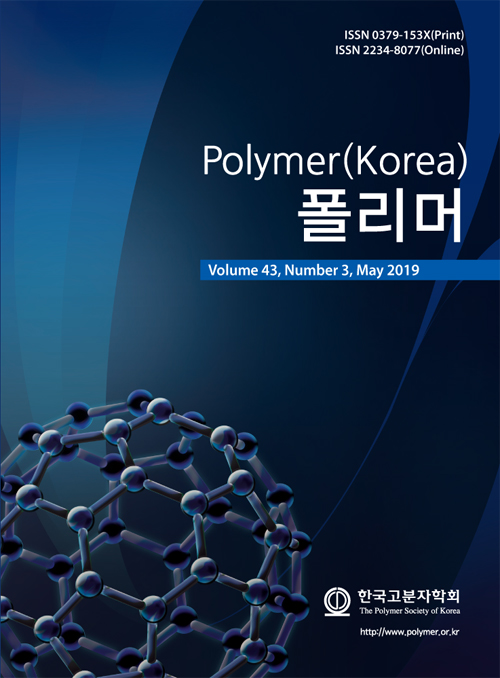- Electrical and Mechanical Properties of PA66/PPE Blend Containing MWCNT
Young Sil Lee, Seul Ki Lee, Jae Hyung Kim, and Kwan Han Yoon†
Dept. of Chemical Engineering, Dept. of Environmental Engineering, Industry-Academic Cooperation Foundation, Kumoh National Institute of Technology, 1 Yangho-dong, Gumi 39177, Korea
- MWCNT 첨가에 의한 PA66/PPE 블렌드의 전기적 기계적 성질
이영실 · 이슬기 · 김재형 · 윤관한†
금오공과대학교 화학공학과, 환경공학과, 산학협력단
Polyamide 66 (PA66)/poly(2,6-dimethyl-4,4-phenylene ether) (PPE) blends containing multi-walled carbon nanotube (MWCNT) were prepared. PPE-L and PPE-H having different melt viscosity were used. During blending, 3 phr of styrene-ethylene-butadiene-styrene (SEBS) as an impact modifier and 2 phr of MWCNT were added. The PA66/PPE (80/20) and (60/40) blends were considerable in terms of the electrical and mechanical properties. The mechanical properties of PA66/PPE-L (80/20) blends were increased up to 2 phr MWCNT and decreased at the higher composition of MWCNT due to the aggregation of MWCNT. The surface resistivity of PA66/PPE-L (80/20) blends was decreased with the MWCNT composition, and showed the percolation threshold at 2 phr MWCNT.
본 연구에서는 multi-walled carbon nanotube(MWCNT)가 첨가된 polyamide 66(PA66)/poly(2,6-dimethyl-4,4-phenylene ether)(PPE) 블렌드를 제조하였다. 이때 용융점도가 다른 2종류의 PPE-H(높은 점도)와 PPE-L(낮은 점도)이 사용되었다. 블렌드 제조 시에 3 phr의 styrene-ethylene-butadiene-styrene(SEBS)가 내충격성 개량제로 사용되었고 2 phr의 MWCNT가 사용되었다. 기계적인 성질과 전기적인 성질을 고려하였을 때 PA66/PPE의 중량비가 (80/20) 및 (60/40)인 블렌드의 성질이 우수하였다. MWCNT의 함량에 따라 PA66/PPE-L(80/20) 블렌드의 기계적 성질은 MWCNT 2 phr까지는 증가하다가 그 이상의 함량에서는 MWCNT의 응집에 의해 감소하였다. PA66/PPE-L(80/20) 블렌드의 전기 전도도는 기계적 성질과 유사하게 MWCNT의 함량에 따라 증가하였고 MWCNT 2 phr에서 임계농도를 나타내었다.
Keywords: polyamide 66, poly(2,6-dimethyl-4,4-phenylene ether), blend, mechanical properties, electrical properties.
- Polymer(Korea) 폴리머
- Frequency : Bimonthly(odd)
ISSN 0379-153X(Print)
ISSN 2234-8077(Online)
Abbr. Polym. Korea - 2023 Impact Factor : 0.4
- Indexed in SCIE
 This Article
This Article
-
2019; 43(3): 331-336
Published online May 25, 2019
- 10.7317/pk.2019.43.3.331
- Received on Nov 16, 2018
- Revised on Jan 14, 2019
- Accepted on Feb 4, 2019
 Correspondence to
Correspondence to
- Kwan Han Yoon
-
Dept. of Chemical Engineering, Dept. of Environmental Engineering, Industry-Academic Cooperation Foundation, Kumoh National Institute of Technology, 1 Yangho-dong, Gumi 39177, Korea
- E-mail: khyoon@kumoh.ac.kr








 Copyright(c) The Polymer Society of Korea. All right reserved.
Copyright(c) The Polymer Society of Korea. All right reserved.